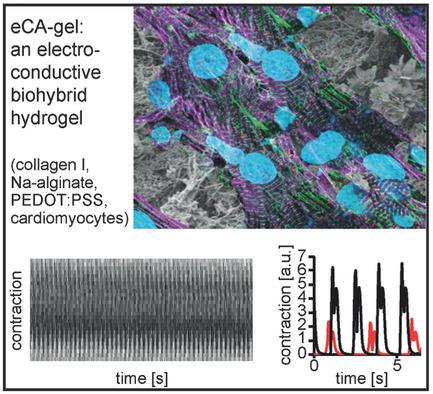当前位置:
X-MOL 学术
›
Adv. Funct. Mater.
›
论文详情
Our official English website, www.x-mol.net, welcomes your feedback! (Note: you will need to create a separate account there.)
Electroconductive Biohybrid Hydrogel for Enhanced Maturation and Beating Properties of Engineered Cardiac Tissues
Advanced Functional Materials ( IF 19.0 ) Pub Date : 2018-09-06 , DOI: 10.1002/adfm.201803951 Kaveh Roshanbinfar 1 , Lena Vogt 2 , Boris Greber 3 , Sebastian Diecke 4, 5, 6 , Aldo R. Boccaccini 2 , Thomas Scheibel 7 , Felix B. Engel 1
Advanced Functional Materials ( IF 19.0 ) Pub Date : 2018-09-06 , DOI: 10.1002/adfm.201803951 Kaveh Roshanbinfar 1 , Lena Vogt 2 , Boris Greber 3 , Sebastian Diecke 4, 5, 6 , Aldo R. Boccaccini 2 , Thomas Scheibel 7 , Felix B. Engel 1
Affiliation

|
Cardiac tissue engineering is a promising strategy to treat heart failure. Yet, several issues remain to be resolved including the prevention of arrhythmia caused by inefficient electrical coupling within the graft and between graft and host tissue. Here, a biohybrid hydrogel composed of collagen, alginate, and electroconductive poly(3,4‐ethylenedioxythiophene):polystyrene sulfonate (PEDOT:PSS) is developed that exhibits extracellular matrix–mimetic fibrous structures and enhanced electrical coupling as well and cardiomyocyte maturation. Presence of PEDOT:PSS in the hydrogel improves electrical conductivity and prevents arrhythmia of tissue constructs containing neonatal rat cardiomyocytes. Moreover, it results in increasing beating frequencies reaching more than 200 beats min−1 endogenous frequencies. In addition, cardiomyocytes exhibit increased alignment and density in these constructs, improved sarcomere organization, and enhanced connexin 43 expression, suggesting maturation of the cardiac tissue. Importantly, the here developed electroconductive biohybrid hydrogels also improve maturation and beating properties of human‐induced pluripotent stem cell–derived cardiomyocytes. These cells exhibit 1.9 µm near adult sarcomeric length, enhanced beating frequency, increased speed of contraction, and larger contraction amplitude. Collectively, the data demonstrate the potential of this electroconductive biohybrid hydrogel to improve tissue engineering approaches to treat heart failure and possibly diseases of other electrically sensitive tissues.
中文翻译:

导电生物混合水凝胶可增强工程心脏组织的成熟度和搏动性能
心脏组织工程学是治疗心力衰竭的一种有前途的策略。然而,还有一些问题有待解决,包括如何预防由于移植物内部以及移植物与宿主组织之间的电耦合效率低下而引起的心律不齐。在这里,开发了一种由胶原蛋白,藻酸盐和导电性聚(3,4-乙撑二氧噻吩):聚苯乙烯磺酸盐(PEDOT:PSS)组成的生物混合水凝胶,它具有细胞外基质-模拟纤维结构,并具有增强的电耦合以及心肌细胞成熟的特性。水凝胶中PEDOT:PSS的存在可改善电导率并防止含有新生大鼠心肌细胞的组织构造的心律不齐。而且,它导致增加的跳动频率达到至少200次以上min -1内生频率。另外,心肌细胞在这些构建体中显示出增加的排列和密度,改善的肌节组织和增强的连接蛋白43表达,表明心脏组织成熟。重要的是,本文开发的导电性生物混合水凝胶还可以改善人类诱导的多能干细胞衍生的心肌细胞的成熟和跳动特性。这些细胞在成年肌节长度附近显示1.9 µm,跳动频率增加,收缩速度加快,收缩幅度更大。总体而言,数据证明了这种导电生物混合水凝胶在改善组织工程学方法以治疗心力衰竭以及其他电敏感组织疾病中的潜力。
更新日期:2018-09-06
中文翻译:

导电生物混合水凝胶可增强工程心脏组织的成熟度和搏动性能
心脏组织工程学是治疗心力衰竭的一种有前途的策略。然而,还有一些问题有待解决,包括如何预防由于移植物内部以及移植物与宿主组织之间的电耦合效率低下而引起的心律不齐。在这里,开发了一种由胶原蛋白,藻酸盐和导电性聚(3,4-乙撑二氧噻吩):聚苯乙烯磺酸盐(PEDOT:PSS)组成的生物混合水凝胶,它具有细胞外基质-模拟纤维结构,并具有增强的电耦合以及心肌细胞成熟的特性。水凝胶中PEDOT:PSS的存在可改善电导率并防止含有新生大鼠心肌细胞的组织构造的心律不齐。而且,它导致增加的跳动频率达到至少200次以上min -1内生频率。另外,心肌细胞在这些构建体中显示出增加的排列和密度,改善的肌节组织和增强的连接蛋白43表达,表明心脏组织成熟。重要的是,本文开发的导电性生物混合水凝胶还可以改善人类诱导的多能干细胞衍生的心肌细胞的成熟和跳动特性。这些细胞在成年肌节长度附近显示1.9 µm,跳动频率增加,收缩速度加快,收缩幅度更大。总体而言,数据证明了这种导电生物混合水凝胶在改善组织工程学方法以治疗心力衰竭以及其他电敏感组织疾病中的潜力。


























 京公网安备 11010802027423号
京公网安备 11010802027423号